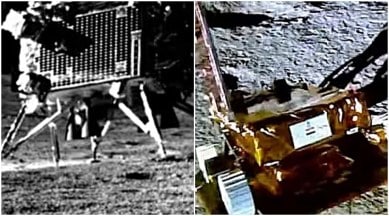Chandrayaan-3 mission: Dawn breaks on Moon, all eyes on lander, rover to wake up
The chances of revival are not very high, but it is not a hopeless situation either. It is possible that the lander or rover module wake up but are unable to regain full functionality.

With a new dawn breaking on Moon on Wednesday, the Indian Space Research Organisation (ISRO) is gearing up to try and nudge the lander and rover modules of Chandrayaan-3 mission to awaken from their sleep in an extremely frigid atmosphere.
An ISRO official said the ground stations will try and revive the lander and rover modules, and the on-board instruments on Thursday or Friday, after optimum sunshine is available.
The chances of revival are not very high, but it is not a hopeless situation either. It is possible that the lander or rover module wake up but are unable to regain full functionality.
The solar-powered Chandrayaan-3 modules had a mission life of just one lunar day, equivalent to about 14 days on Earth. The electronics were not designed to withstand the extremely cold night-time temperatures on the Moon, which drops well below -200 degrees Celsius near the south pole, where Chandrayaan-3 has landed.
Spacecraft meant to survive the night on the Moon are usually equipped with some onboard heating mechanism. Russia’s Luna-25, which failed to land on the Moon, had such a system. But Chandrayaan-3 was never meant to live beyond one lunar day.
However, once the main science objectives of Chandrayaan-3 were over, ISRO had decided to take its chances and try to extend the lifespan of the lander and rover. Accordingly, it shut down the operations of all instruments a little earlier than sunset, and put them in sleep mode, hoping that the batteries that had been fully charged by then would keep the instruments warm enough to survive the night.
If they wake up fully fit, the lander and rover can keep operating for another 14 Earth days at least, thus enriching the scientific data and observations they have been sending to the ground stations. Already, Chandrayaan-3 has collected some exciting new data about the Moon regarding its composition and environment. This includes a first-of-its-kind temperature profile of the lunar top-soil near the South Pole by the CHaSTE (Chandra’s Surface Thermophysical Experiment) instrument.
In a surprise, the lander module was also made to do a ‘hop experiment’ just before it was put to sleep — the lander was made to jump, about 40 cm from the surface, and it landed safely about 30-40 cm away from its original location. Even though it was a very small jump, the hop experiment demonstrated ISRO’s capability to get the lander to fire its engines and produce the thrust to lift it off the surface.
This capability is key to future missions that might involve the lander to return to Earth with samples from the Moon.